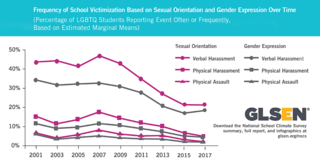Gender
It’s Not “Getting Better” for LGBTQ Youth
The #TrumpEffect and school safety for kids who identify as LGBTQ.
Posted October 19, 2018
This week GLSEN just released their latest National School Climate Survey data which is based on the experiences of over 23,000 school-age students surveyed during the 2017 school year. GLSEN has been collecting this data since 1999, and this is the first year that there hasn’t been a continual reduction in incidences of homophobic and transphobic harassment. In fact, there has been an increase in some forms of anti-LGBTQ bias in schools. This reflects what many educators and students have been reporting in the wake of the Trump election which is an increase in acts of intimidation, bias, and violence at school (Rogers et al 2017), which some groups have called the #TrumpEffect (Southern Poverty Law Center, 2016).

For example, for the first time since 2007, school victimization based on gender expression and sexual orientation has stayed steady or increased. More specifically, there has been a steady increase of negative remarks about transgender people between 2013 and 2017. Although there had been a steady decline in the frequency of school staff making homophobic remarks from 2007 to 2013, there has been no change from 2013 to 2017.
Other important results from this survey include:
- 60% of LGBTQ youth report feeling unsafe at school
- 34% of LGBTQ youth missed at least one day of school in the past month due to feeling unsafe or uncomfortable
- LGBTQ avoid school functions (75%) and extracurricular activities (70%) as a result of these feelings
- 18% of LGBTQ have changed schools for safety reasons
- Black/African American LGBTQ students were more likely than Hispanic/Latinx, White, and Asian/ South Asian/Pacific Islander LGBTQ students to experience out-of-school suspension or expulsion.
- Students in rural schools, religious schools, and in schools in the South and Midwest experiences more hostile climates than in other contexts.
If students don’t feel safe at school, they will not be able to focus on other important development functions such as health identity development and academic growth. Maslow’s hierarchy of needs places safety needs at the foundation of human development and argues that these must be satisfied before any individual can focus on more advanced developmental tasks.
The low levels of safety felt by LGBTQ youth reflects their experiences with reporting violence at school:
- 55.3% of LGBTQ students who were harassed or assaulted in school did not report the incident to school staff, most commonly because they doubted that effective intervention would occur or feared the situation could become worse if reported.
- 60.4% of the students who did report an incident said that school staff did nothing in response or told the student to ignore it.
This reflects some troubling findings in my own research about sexual harassment at school and the fairly low visibility and accessibility of trained Title IX coordinators. These individuals are the personnel that every school district must employ who are supposed to address such forms of violence at schools. I wrote about the problems with Title IX coordinators in an earlier post (Meyer et al 2018).

Encouragingly, the participants in this survey also reflect the resilience and civic engagement we have seen on the part of school-aged youth. The vast majority (80.2%) indicated that they had engaged in at least one type of activism over the past year and most LGBTQ youth (74%) were involved with their schools Gay-Straight Alliance/Gender and Sexuality Alliance (GSA). Students who reported having a GSA at their school:
- Were less likely to miss school because of safety concerns (28.7% vs. 41.8%)
- Were more likely to report that school personnel intervened when hearing homophobic remarks compared to students without a GSA — 18.2% vs. 11.3% said that staff intervene most of the time or always;
- Felt greater belonging to their school community
I am grateful to organizations like GLSEN who are able to regularly collect data and provide a clear snapshot of the climate in schools around gender and sexual diversity issues. These reports provide vital information about urgent issues for educators and researchers and the impacts of how the larger social and political events impact the daily lives of some of our most vulnerable, and resilient, youth. I look forward to diving into this report further and invite you to do the same. It is available on GLSEN’s website.
References
Kosciw, J. G., Greytak, E. A., Zongrone, A. D., Clark, C. M., & Truong, N. L. . (2018). The 2017 National School Climate Survey: The experiences of lesbian, gay, bisexual, transgender, and queer youth in our nation’s schools. GLSEN: New York
Meyer, E. J., Somoza-Norton, A., Rubin, A., Lovgren, N., & Quantz, M. (2018). Title IX coordinators in U.S. schools: Challenges addressing sex discrimination in the #MeToo era. Educational Policy Analysis Archives, 26(68), 1-28.
Rogers, J., Franke, M. Yun, J.E., Ishimoto, M., Diera, C., Geller, R., Berryman, A., Brenes, T. (2017). Teaching and Learning in the Age of Trump: Increasing Stress and Hostility in America's High Schools. In. Los Angeles, CA: UCLA’s Institute for Democracy, Education, and Access.
Southern Poverty Law Center. (2016). After Election Day: The Trump Effect // The Impact of the 2016 Presidential Election on our Nation's Schools. Retrieved from Montgomery, AL: https://www.splcenter.org/sites/default/files/the_trump_effect.pdf


